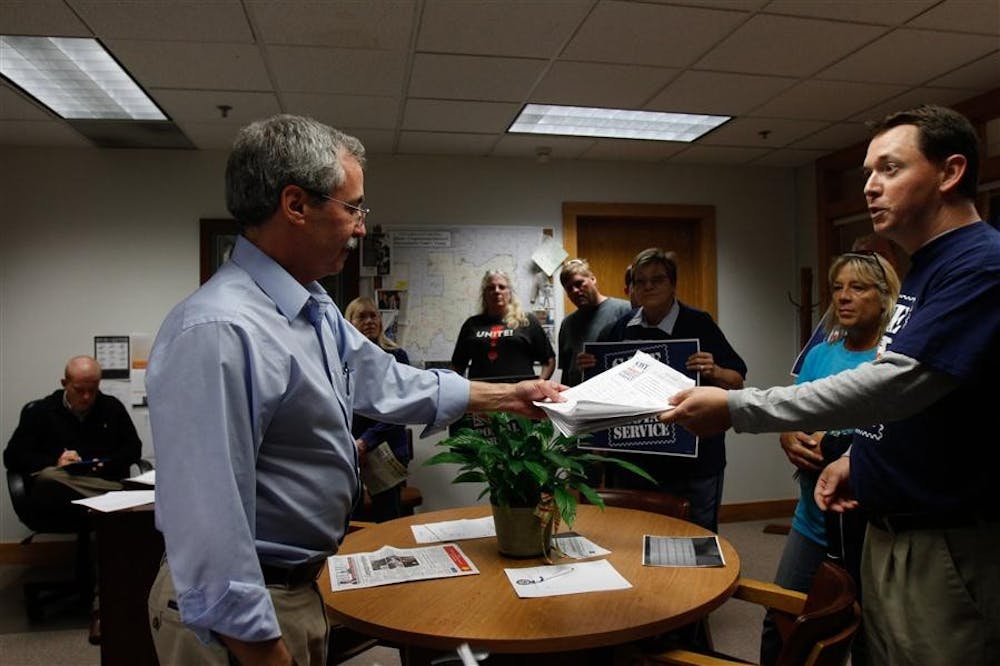Bloomington’s mail processing facility is one of 252 plants facing possible closure if a new cost-cutting plan by the U.S. Postal Service comes to fruition.
Fighting bankruptcy, the Postal Service is attempting to save $2.1 billion a year by closing the plants and cutting 280,000 positions by March. The plan could also mean an end to overnight delivery for first class mail, including letters, post cards and bills, even if the sender and recipient are in the same city.
If the Bloomington plant closes, as many as 30 employees could be let go or transferred out of the city, said Ken Hill, president of the National Association of Letter Carriers South Central Indiana Branch 828.
“For some, this transfer could be up to a 50-mile change, which means families would have to move,” Hill said. “That can’t be good for Bloomington.”
The plan comes after a tumultuous year for the Postal Service, which has seen the company face a possible debt default, proposals to close down 37,000 local branches across the country and nation-wide protests by letter carriers.
Some politicians, both Republicans and Democrats, have criticized the plan and Postmaster General Patrick R. Donahoe.
“This guy, this so-called postmaster general, should be fired because of a lack of any imagination or initiative,” U.S. Rep. Peter DeFazio, D-Ore., said to Congress Monday.
“He’s proposing the death knell for the great United States Postal Service.”
U.S. Sen. Susan Collins, R-Maine, the top Republican on the Senate committee that oversees the Postal Service, told the Los Angeles Times she also was highly critical of the plan.
“Time and time again in the face of more red ink, the USPS puts forward ideas that could well accelerate its death spiral,” Collins said.
Donahoe has said the cost-cutting measures are a necessity, blaming the Postal Service’s descent toward bankruptcy on package delivery services, online billing options and the rise of email.
Another major concern, Donahoe said, has been a steep decline in first class mail, which accounts for 49 percent of its revenue.
As of September, the Postal Service faced an $8.3 billion budget deficit.
Union leaders like Hill, however, argue the deficit is the result of another matter.
While he admits some modern conveniences have hurt the Postal Service, Hill said the company has managed to decrease other costs already and retain a viable business model.
“I strongly disagree that a decline in first class mail is really the death nail,”
Hill said.
Instead, union leaders point to legislation passed in 2006 that requires the Postal Service to pay its health care benefits for future retirees far in advance. Because of the legislation, the USPS must come up with 75 years’ worth of benefits within 10 years.
The Postal Service still had a $112 million operations profit this year, according to a USPS Preliminary Financial Information from October.
“The real loss of revenue is coming from this unfair practice of forcing us to pre-pay 70 years’ worth of benefits,” Hill said.
Other Indiana plants facing possible closure include those in Kokomo and Columbus, and many rural post offices around the state could also be closed, Hill said. The Bloomington plant serves Bloomington, Ellettsville, Spencer and Bloomfield, making Indianapolis the closest service plant for those customers.
Hill said closing so many plants and local branches can only make the problem worse and urges customers to sign online petitions against the plan.
“The Postal Service has always been and will always be here for the public as long as there’s the need for the goods and services we provide,” Hill said. “But we’re going to need help from the public now to keep the doors open.”
Postal plant on track for closure

Get stories like this in your inbox
Subscribe





